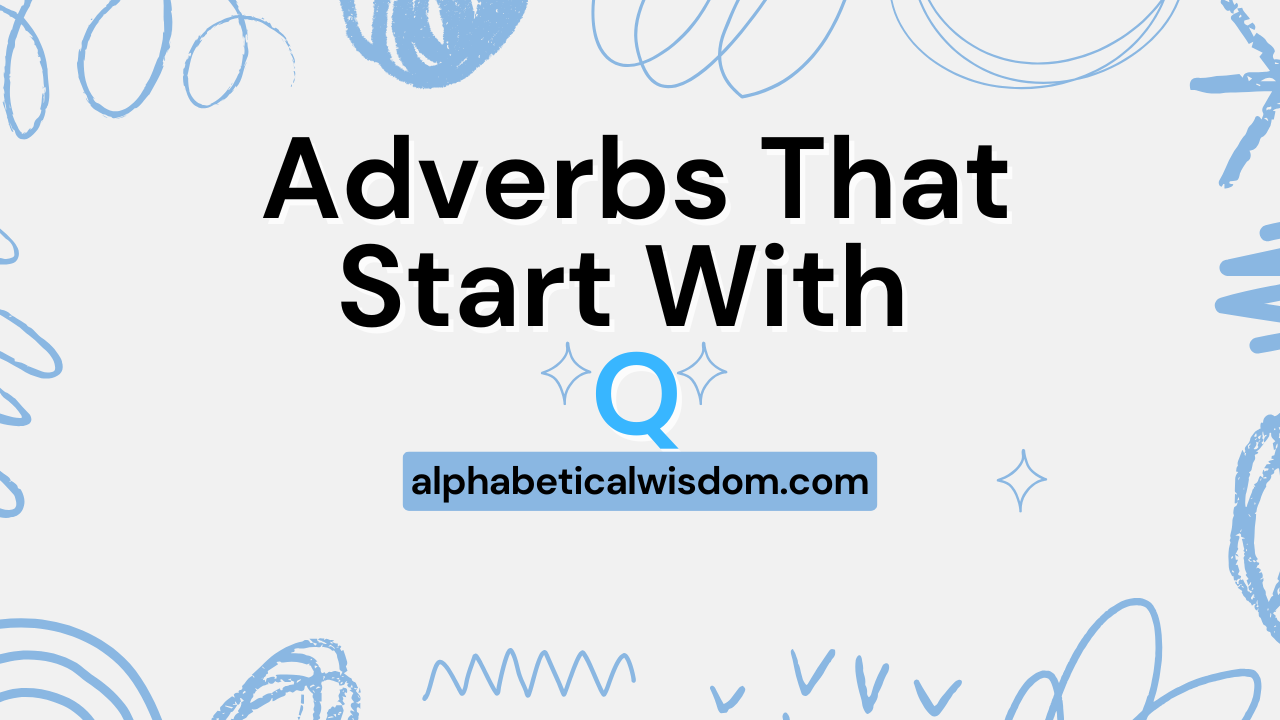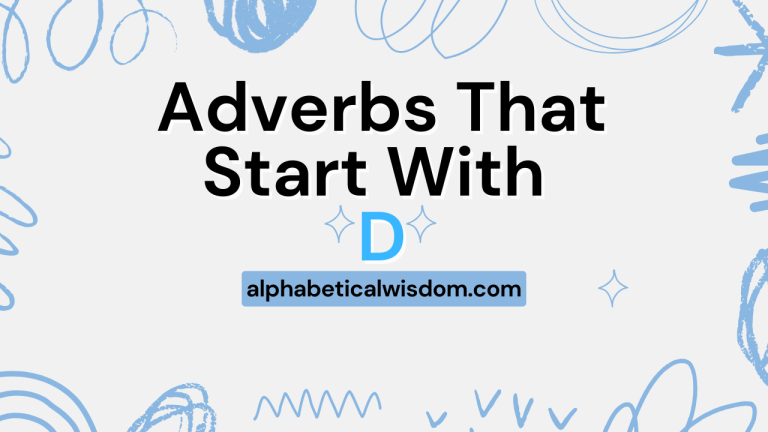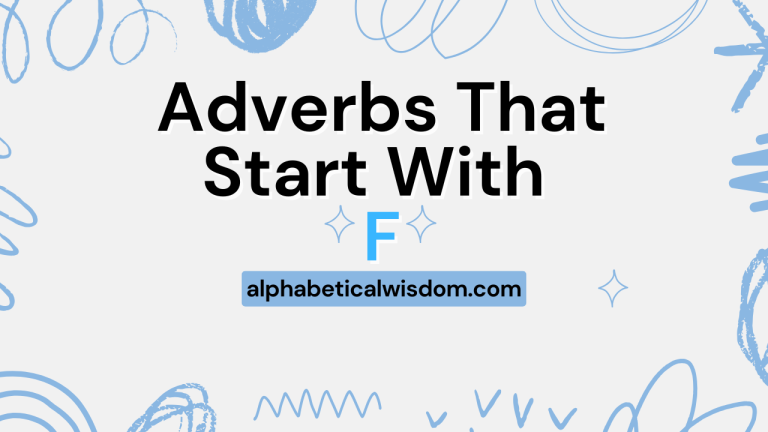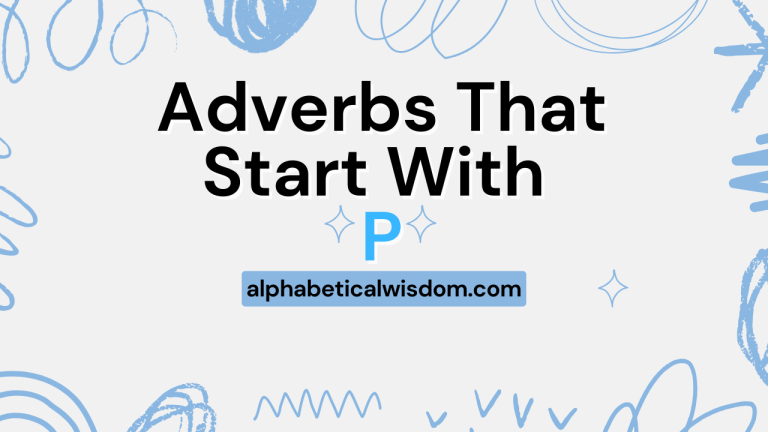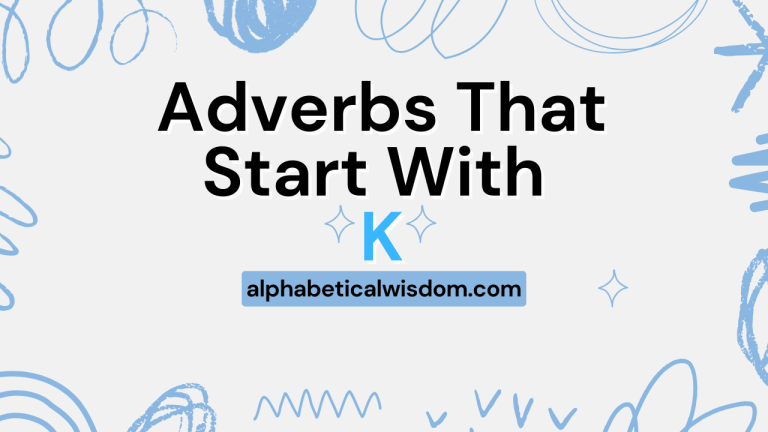Adverbs That Start With Q: A Comprehensive Guide
Understanding adverbs is crucial for mastering English grammar, as they add detail and nuance to sentences. Adverbs modify verbs, adjectives, or other adverbs, providing information about how, when, where, or to what extent an action is performed.
This article focuses specifically on adverbs that begin with the letter “Q,” exploring their meanings, usage, and common contexts. This guide is perfect for English language learners, students, and anyone looking to refine their understanding and use of adverbs in both written and spoken English.
By exploring the nuances of these “Q” adverbs, you can significantly enhance your communicative abilities and grammatical accuracy.
Table of Contents
- Introduction
- Definition of Adverbs
- Structural Breakdown
- Types and Categories of Adverbs Starting With Q
- Examples of Adverbs Starting With Q
- Usage Rules
- Common Mistakes
- Practice Exercises
- Advanced Topics
- FAQ
- Conclusion
Definition of Adverbs
An adverb is a word that modifies a verb, an adjective, another adverb, a phrase, or a clause. Adverbs provide information about the manner, time, place, cause, or degree of an action or description.
They are essential for adding detail and precision to language, making sentences more informative and engaging. Recognizing and using adverbs correctly is a fundamental aspect of English grammar proficiency.
Without adverbs, our sentences would lack depth, and our communication would be less effective. Mastering adverbs allows for more nuanced and sophisticated expression.
Classification of Adverbs
Adverbs can be classified based on their function within a sentence. Some common classifications include adverbs of manner, time, place, frequency, degree, and purpose. Adverbs of manner describe how an action is performed (e.g., quickly, slowly). Adverbs of time indicate when an action occurs (e.g., yesterday, soon). Adverbs of place specify where an action takes place (e.g., here, there). Adverbs of frequency denote how often an action happens (e.g., always, never). Adverbs of degree express the intensity of an action or quality (e.g., very, extremely). Understanding these classifications helps in identifying and using adverbs effectively.
Function of Adverbs
The primary function of an adverb is to modify other words or phrases, providing additional information and context. Adverbs can modify verbs by describing how an action is carried out. For example, in the sentence “She sings beautifully,” the adverb beautifully modifies the verb sings. Adverbs can also modify adjectives, intensifying or weakening their meaning. For instance, in the phrase “extremely tall,” the adverb extremely modifies the adjective tall. Additionally, adverbs can modify other adverbs, adding further detail. In the sentence “He ran very quickly,” the adverb very modifies the adverb quickly. This multifaceted function makes adverbs indispensable for precise communication.
Contexts of Adverb Use
Adverbs are used in a wide range of contexts, from formal writing to everyday conversation. In academic writing, adverbs help to provide precise details and support arguments effectively.
In creative writing, adverbs can enhance imagery and create vivid descriptions. In business communication, adverbs can clarify instructions and convey information accurately.
Even in casual conversations, adverbs add color and nuance to our speech. The ability to use adverbs appropriately in different contexts demonstrates a strong command of the English language and enhances overall communication skills.
Whether you are writing a research paper, telling a story, or giving a presentation, adverbs play a crucial role in conveying your message effectively.
Structural Breakdown
The structure of adverbs can vary. Many adverbs are formed by adding the suffix “-ly” to an adjective (e.g., quick becomes quickly). However, not all adverbs end in “-ly,” and some words that end in “-ly” are not adverbs (e.g., friendly is an adjective). Some adverbs are single words (e.g., now, here), while others are phrases (e.g., in a hurry, at once). Understanding the different forms and structures of adverbs is essential for accurate identification and usage. Recognizing these structural elements allows for more precise and effective communication, ensuring clarity and avoiding grammatical errors.
Types and Categories of Adverbs Starting With Q
While the number of adverbs starting with the letter “Q” is relatively small, they still fall into various categories based on their function. These adverbs often add a specific nuance to sentences, and understanding their categories helps in using them correctly.
Let’s explore some of these categories with relevant examples.
Adverbs of Manner
Adverbs of manner describe how an action is performed. While not many adverbs of manner start with “Q,” those that do often indicate a sense of peculiarity or unusualness.
For example, imagine describing how someone acts in a strange or unconventional way. This category focuses on the *how* of an action, painting a clearer picture for the reader or listener.
Adverbs of Degree
Adverbs of degree express the intensity or extent of an action or quality. Adverbs of degree that start with “Q” might emphasize the extent to which something is true or the level of intensity involved.
These adverbs are crucial for adding emphasis and precision to descriptions, clarifying the magnitude of an action or characteristic. They allow speakers and writers to convey the strength of their feelings or observations more effectively.
Adverbs of Frequency
Adverbs of frequency indicate how often an action occurs. While less common with “Q,” if such an adverb existed, it would specify how frequently something happens.
These adverbs are essential for establishing routines, habits, and recurring events. They provide a sense of rhythm and predictability to language, allowing for clear communication about the regularity of actions.
Examples of Adverbs Starting With Q
Due to the limited number of adverbs starting with the letter “Q,” examples are scarce. However, it’s important to understand how such adverbs, if they existed more abundantly, would function within different categories.
The following examples illustrate hypothetical uses, emphasizing the potential role of “Q” adverbs in enriching the English language.
Adverbs of Manner Examples
Consider the following examples that showcase how adverbs of manner, if they started with “Q,” could be used. Keep in mind that these are illustrative.
| Sentence | Explanation |
|---|---|
| She performed the task quaintly, with an old-fashioned charm. | Quaintly describes the manner of performance, suggesting an endearing, old-fashioned style. |
| He answered the question quizzically, tilting his head in confusion. | Quizzically describes how he answered, indicating a questioning or perplexed manner. |
| The bird chirped quietly, almost as if it were whispering a secret. | Quietly describes the manner of chirping, indicating a soft and subdued sound. |
| The machine operated quickly, processing the data in seconds. | Quickly describes the speed of operation, indicating a fast and efficient process. |
| He glanced questioningly at his companion, seeking confirmation. | Questioningly describes the manner of his glance, suggesting he was seeking an answer or clarification. |
| The students worked quietly, focusing on their individual tasks. | Quietly describes the manner of working, indicating a calm and focused environment. |
| The river flowed quickly, carrying debris downstream. | Quickly describes the speed of the river’s flow, indicating a rapid current. |
| The chef prepared the meal quickly, ensuring it was served on time. | Quickly describes how the meal was prepared, indicating a fast and efficient process. |
| She moved quietly through the house, not wanting to wake anyone. | Quietly describes her manner of movement, indicating a gentle and silent approach. |
| He spoke quizzically, making everyone wonder what he meant. | Quizzically describes his manner of speaking, suggesting a puzzling or enigmatic tone. |
| The actor delivered his lines quaintly, adding a unique charm to the character. | Quaintly describes the manner of delivery, suggesting an old-fashioned or unusual style. |
| The artist painted quickly, capturing the fleeting moment on canvas. | Quickly describes the speed of painting, indicating a rapid and efficient process. |
| The cat crept quietly through the grass, stalking its prey. | Quietly describes the cat’s manner of movement, indicating a silent and stealthy approach. |
| The detective questioned the suspect questioningly, seeking the truth. | Questioningly describes the manner of questioning, suggesting a skeptical and probing approach. |
| The old clock ticked quietly in the corner of the room. | Quietly describes the manner of ticking, indicating a soft and subdued sound. |
| The magician performed his tricks quickly, leaving the audience amazed. | Quickly describes the speed of performance, indicating a fast and impressive display. |
| She accepted the award quietly, overwhelmed with emotion. | Quietly describes her manner of acceptance, indicating a humble and subdued reaction. |
| The wind howled quietly through the trees, creating an eerie atmosphere. | Quietly describes the manner of howling, indicating a soft and subtle sound. |
| He observed the scene questioningly, trying to understand what was happening. | Questioningly describes his manner of observation, suggesting a curious and inquisitive approach. |
| The child played quietly with his toys, lost in his own world. | Quietly describes the manner of playing, indicating a calm and peaceful activity. |
| The program installed quickly, without any issues or errors. | Quickly describes the speed of installation, indicating a fast and efficient process. |
| She packed her bags quickly, eager to start her vacation. | Quickly describes the speed of packing, indicating a fast and efficient action. |
| The news spread quickly, reaching every corner of the town. | Quickly describes the speed of spreading, indicating a rapid and widespread dissemination. |
| The rain fell quietly on the roof, lulling everyone to sleep. | Quietly describes the manner of falling, indicating a soft and gentle sound. |
Adverbs of Degree Examples
Here are some examples illustrating how adverbs of degree, starting with “Q,” could potentially be used to express intensity or extent.
| Sentence | Explanation |
|---|---|
| The task was quite challenging, requiring significant effort. | Quite indicates a moderate degree of challenge. |
| He was quite certain about his decision. | Quite modifies “certain,” indicating a reasonable level of assurance. |
| The movie was quite enjoyable, with a compelling storyline. | Quite describes the degree of enjoyment, suggesting a pleasant experience. |
| She was quite surprised by the unexpected news. | Quite indicates the level of surprise, suggesting a considerable reaction. |
| The weather is quite warm today, perfect for a picnic. | Quite describes the degree of warmth, indicating a moderately warm temperature. |
| He is quite talented at playing the piano. | Quite modifies “talented,” indicating a noticeable level of skill. |
| The book was quite interesting, filled with fascinating facts. | Quite describes the degree of interest, suggesting an engaging read. |
| She is quite knowledgeable about history. | Quite modifies “knowledgeable,” indicating a considerable understanding of the subject. |
| The food was quite delicious, a culinary masterpiece. | Quite describes the degree of deliciousness, suggesting a very tasty meal. |
| He is quite dedicated to his work. | Quite modifies “dedicated,” indicating a strong commitment to his job. |
| The house is quite spacious, with plenty of room for everyone. | Quite describes the degree of spaciousness, indicating a reasonably large area. |
| She is quite skilled at solving complex problems. | Quite modifies “skilled,” indicating a notable ability to handle difficult tasks. |
| The scenery was quite breathtaking, a stunning natural landscape. | Quite describes the degree of beauty, suggesting a very impressive view. |
| He is quite experienced in managing large teams. | Quite modifies “experienced,” indicating a substantial background in leadership. |
| The project was quite successful, exceeding all expectations. | Quite describes the degree of success, suggesting a very positive outcome. |
| She is quite fluent in several languages. | Quite modifies “fluent,” indicating a considerable proficiency in multiple languages. |
| The challenge was quite difficult, requiring careful planning. | Quite describes the degree of difficulty, suggesting a demanding task. |
| He is quite passionate about environmental conservation. | Quite modifies “passionate,” indicating a strong enthusiasm for the cause. |
| The performance was quite captivating, holding the audience’s attention. | Quite describes the degree of captivation, suggesting a very engaging show. |
| She is quite adept at adapting to new situations. | Quite modifies “adept,” indicating a notable ability to adjust to changing environments. |
| The solution was quite innovative, showcasing creativity and ingenuity. | Quite describes the degree of innovation, suggesting a highly original idea. |
| He is quite involved in community service. | Quite modifies “involved,” indicating a significant participation in local activities. |
| The experiment was quite revealing, providing valuable insights. | Quite describes the degree of revelation, suggesting a highly informative result. |
| She is quite dedicated to her family. | Quite modifies “dedicated,” indicating a strong commitment to her loved ones. |
Adverbs of Frequency Examples
While adverbs of frequency starting with “Q” are uncommon, these examples illustrate their potential use in indicating how often an action occurs.
| Sentence | Explanation |
|---|---|
| Quarterly, the company releases its financial reports. | Quarterly indicates that the reports are released every three months. |
| The magazine is published quarterly, offering seasonal updates. | Quarterly specifies that the magazine appears four times a year. |
| We review our progress quarterly to ensure we’re on track. | Quarterly indicates that progress is reviewed every three months. |
| The organization holds meetings quarterly, discussing important issues. | Quarterly specifies that meetings occur four times a year. |
| The garden needs fertilizing quarterly for optimal growth. | Quarterly indicates that fertilization should occur every three months. |
| The software receives updates quarterly, improving its performance. | Quarterly specifies that updates are released four times a year. |
| The doctor recommends check-ups quarterly to monitor health. | Quarterly indicates that check-ups should occur every three months. |
| The sports team has tournaments quarterly, showcasing their skills. | Quarterly specifies that tournaments are held four times a year. |
| The school organizes events quarterly, fostering community spirit. | Quarterly indicates that events are organized every three months. |
| The charity provides aid quarterly to those in need. | Quarterly specifies that aid is given four times a year. |
| The council publishes newsletters quarterly, informing residents about local news. | Quarterly indicates that newsletters are published every three months. |
| The farmers harvest their crops quarterly, depending on the season. | Quarterly specifies that harvests occur four times a year. |
| The company conducts audits quarterly, ensuring financial integrity. | Quarterly indicates that audits are conducted every three months. |
| The artists showcase their work quarterly, displaying new creations. | Quarterly specifies that showcases occur four times a year. |
| The chefs update their menu quarterly, introducing seasonal dishes. | Quarterly indicates that menus are updated every three months. |
| The researchers publish findings quarterly, sharing their latest discoveries. | Quarterly specifies that findings are published four times a year. |
| The musicians perform concerts quarterly, entertaining audiences. | Quarterly indicates that concerts are held every three months. |
| The writers release stories quarterly, captivating readers. | Quarterly specifies that stories are released four times a year. |
| The dancers perform shows quarterly, showcasing their talent. | Quarterly indicates that shows are performed every three months. |
| The volunteers organize clean-ups quarterly, improving the environment. | Quarterly specifies that clean-ups are organized four times a year. |
| The historians update their records quarterly, preserving historical data. | Quarterly indicates that records are updated every three months. |
| The scientists conduct experiments quarterly, exploring new possibilities. | Quarterly specifies that experiments are conducted four times a year. |
| The engineers maintain equipment quarterly, ensuring optimal performance. | Quarterly indicates that equipment is maintained every three months. |
| The librarians update collections quarterly, offering a diverse range of books. | Quarterly specifies that collections are updated four times a year. |
Usage Rules
Adverbs, including those starting with “Q,” generally follow certain placement rules within a sentence. Understanding these rules is crucial for ensuring clarity and grammatical correctness.
However, the flexibility of adverb placement can also be used to emphasize different parts of a sentence.
Placement of Adverbs
Adverbs of manner are usually placed after the verb they modify or after the object if there is one. Adverbs of frequency typically go before the main verb but after auxiliary verbs.
Adverbs of degree usually precede the adjective or adverb they modify. However, these are general guidelines, and the specific placement can vary depending on the desired emphasis and sentence structure.
The key is to ensure that the adverb’s placement clarifies its relationship to the word or phrase it modifies.
Exceptions to the Rules
There are exceptions to the general rules of adverb placement. For example, sometimes adverbs of frequency can be placed at the beginning or end of a sentence for emphasis.
Additionally, certain adverbs have fixed positions due to idiomatic usage. Recognizing these exceptions requires a keen ear for language and an understanding of common expressions.
Paying attention to context and usage patterns is crucial for mastering adverb placement.
Special Cases
Certain adverbs can function differently depending on the context. For example, some adverbs can act as intensifiers, while others can serve as sentence adverbs, modifying the entire clause rather than a single word.
Understanding these special cases requires a deeper understanding of adverbial function and sentence structure. Analyzing the role of adverbs within complex sentences is essential for mastering their nuanced usage.
Common Mistakes
One common mistake is confusing adverbs with adjectives. Remember that adverbs modify verbs, adjectives, or other adverbs, while adjectives modify nouns.
Another mistake is incorrect adverb placement, which can lead to ambiguity or awkward phrasing. Additionally, using adverbs excessively can make writing verbose and unclear.
Being mindful of these common pitfalls can help improve the accuracy and clarity of your writing.
| Incorrect | Correct | Explanation |
|---|---|---|
| He is a quick runner. | He is a fast runner. He runs quickly. | “Quick” is an adjective; “quickly” is the adverb. “Fast” can be both. |
| She quiet spoke. | She spoke quietly. | Adverbs typically modify verbs; “quietly” is the correct form. |
| He very is happy. | He is very happy. | Adverbs of degree usually precede the adjective they modify. |
Practice Exercises
Test your understanding of adverbs with these practice exercises. Each exercise focuses on a different aspect of adverb usage, from identification to sentence construction and error correction.
Working through these exercises will reinforce your knowledge and improve your ability to use adverbs effectively.
Exercise 1: Identifying Adverbs
Identify the adverbs in the following sentences.
| Question | Answer |
|---|---|
| She sings beautifully. | beautifully |
| He arrived late. | late |
| They often visit. | often |
| The cat jumped quickly. | quickly |
| We will leave soon. | soon |
| The child quietly played. | quietly |
| She spoke clearly. | clearly |
| He works hard. | hard |
| They always arrive on time. | always |
| The dog barked loudly. | loudly |
Exercise 2: Using Adverbs in Sentences
Fill in the blanks with appropriate adverbs.
| Question | Answer |
|---|---|
| The students listened ________ to the teacher. (attentively) | The students listened attentively to the teacher. |
| He runs ________. (quickly) | He runs quickly. |
| She ________ visits her grandmother. (often) | She often visits her grandmother. |
| The rain fell ________. (heavily) | The rain fell heavily. |
| They completed the task ________. (efficiently) | They completed the task efficiently. |
| He ________ checks his email. (daily) | He daily checks his email. |
| The bird sang ________. (sweetly) | The bird sang sweetly. |
| She dances ________. (gracefully) | She dances gracefully. |
| He spoke ________. (softly) | He spoke softly. |
| They left ________. (early) | They left early. |
Exercise 3: Correcting Errors
Correct the errors in the following sentences.
| Question | Answer |
|---|---|
| He is a quick learner. (Incorrect) | He learns quickly. (Correct) |
| She sings good. (Incorrect) | She sings well. (Correct) |
| They arrived late yesterday. (Correct) | They arrived late yesterday. (Correct) |
| He is very happy. (Correct) | He is very happy. (Correct) |
| She spoke quiet. (Incorrect) | She spoke quietly. (Correct) |
| They worked hard. (Correct) | They worked hard. (Correct) |
| He is a slow driver. (Incorrect) | He drives slowly. (Correct) |
| She answered the question correct. (Incorrect) | She answered the question correctly. (Correct) |
| They finished the project fast. (Incorrect) | They finished the project quickly. (Correct) |
| He reads good. (Incorrect) | He reads well. (Correct) |
Advanced Topics
For advanced learners, understanding conjunctive adverbs, adverbial phrases, and adverbial clauses is essential for mastering complex sentence structures and enhancing writing skills. These elements provide greater flexibility and nuance in expressing relationships between ideas and adding detail to sentences.
Conjunctive Adverbs
Conjunctive adverbs (e.g., however, therefore, moreover) connect two independent clauses, showing the relationship between them. They provide a smoother transition between ideas than simply using a coordinating conjunction. Conjunctive adverbs add sophistication to writing and enhance the flow of arguments. Mastering their usage is key to crafting clear and persuasive prose.
Adverbial Phrases
Adverbial phrases are groups of words that function as adverbs, modifying verbs, adjectives, or other adverbs. They can provide information about time, place, manner, or reason.
Adverbial phrases add detail and depth to sentences, allowing for more precise and descriptive writing. Understanding their structure and function is crucial for advanced grammar skills.
Adverbial Clauses
Adverbial clauses are dependent clauses that function as adverbs, modifying the main clause of a sentence. They begin with subordinating conjunctions (e.g., because, although, if) and provide information about time, place, reason, condition, or contrast. Adverbial clauses enable complex sentence structures and allow for a more nuanced expression of ideas. Mastering their usage is essential for advanced writing and comprehension skills.
FAQ
- What is the main function of an adverb?
The main function of an adverb is to modify a verb, adjective, another adverb, a phrase, or a clause, providing information about manner, time, place, cause, or degree.
- How can I identify an adverb in a sentence?
Look for words that answer questions like “how,” “when,” “where,” “why,” or “to what extent.” Many adverbs end in “-ly,” but not all words ending in “-ly” are adverbs.
- What are the different types of adverbs?
Common types of adverbs include adverbs of manner, time, place, frequency, degree, and purpose. Each type provides different information about the action or description.
- Where should I place an adverb in a sentence?
Adverb placement depends on the type of adverb and the desired emphasis. Adverbs of manner usually follow the verb or object, while adverbs of frequency typically precede the main verb.
- What is the difference between an adverb and an adjective?
Adverbs modify verbs, adjectives, or other adverbs, while adjectives modify nouns. This is a crucial distinction to remember for correct usage.
- Can an adverb modify another adverb?
Yes, adverbs can modify other adverbs, adding further detail and intensity. For example, “He ran very quickly.”
- What are conjunctive adverbs, and how are they used?
Conjunctive adverbs connect two independent clauses, showing the relationship between them. Examples include however, therefore, and moreover.
- How can I avoid common mistakes when using adverbs?
Pay attention to the distinction between adverbs and adjectives, be mindful of adverb placement, and avoid using adverbs excessively to maintain clarity.
- What are adverbial phrases and clauses?
Adverbial phrases are groups of words that function as adverbs, while adverbial clauses are dependent clauses that function as adverbs, providing additional information to the main clause.
- Are there any adverbs that do not end in “-ly”?
Yes, many adverbs do not end in “-ly,” such as soon, here, there, now, then, and very. Recognizing these adverbs is important for accurate identification.
Conclusion
Mastering adverbs is essential for effective communication in English. While adverbs starting with “Q” are relatively rare, understanding their potential usage and the general principles of adverb function is crucial.
By learning the different types of adverbs, their placement rules, and common mistakes to avoid, you can significantly enhance your writing and speaking skills. Remember to practice identifying and using adverbs in various contexts to
practice identifying and using adverbs in various contexts to achieve fluency and precision.
Whether you are a student, a professional, or simply an English language enthusiast, a solid understanding of adverbs will undoubtedly elevate your linguistic capabilities. Continued practice and attention to detail will help you harness the full power of adverbs, enabling you to express yourself with clarity and nuance.
